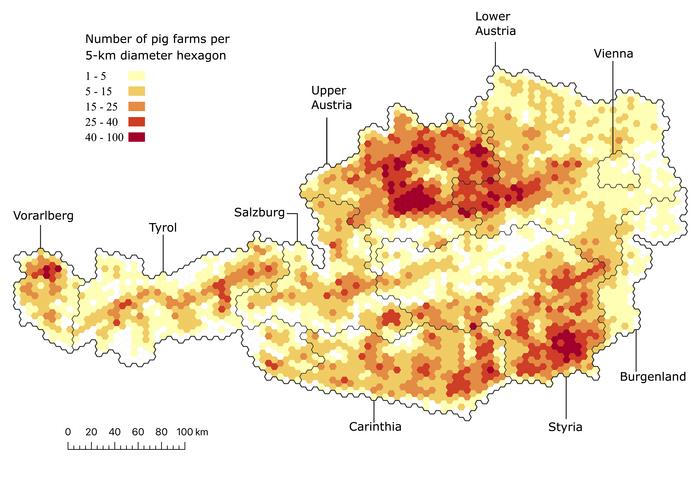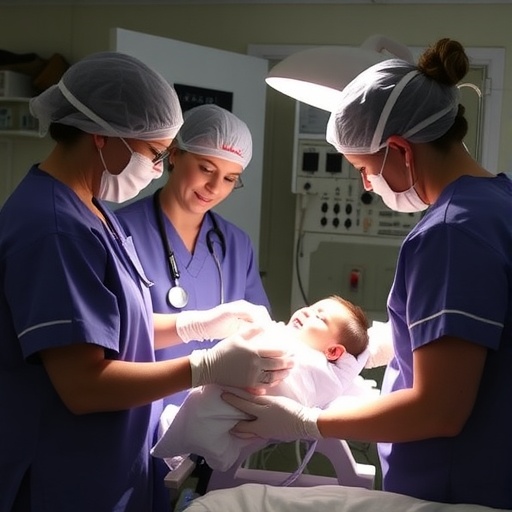The transfer of pigs from one place to another poses the risk of spreading infectious diseases. Knowing how holdings (e.g., farms, markets, etc.) are connected is therefore of crucial importance. In a study by the Complexity Science Hub, the University of Veterinary Medicine Vienna, and the Austrian Agency for Health and Food Safety (AGES), researchers are now drawing a map of the Austrian pig trade for the first time.

Credit: © Complexity Science Hub
The transfer of pigs from one place to another poses the risk of spreading infectious diseases. Knowing how holdings (e.g., farms, markets, etc.) are connected is therefore of crucial importance. In a study by the Complexity Science Hub, the University of Veterinary Medicine Vienna, and the Austrian Agency for Health and Food Safety (AGES), researchers are now drawing a map of the Austrian pig trade for the first time.
Every year, around 250,000 transfers of pigs take place in Austria. Each of these transfers carries a certain risk of spreading swine infectious diseases. To identify possible risks of disease spread and develop targeted preventive measures, it is necessary to know how individual holdings are interconnected.
“We used anonymized daily movement data of live pigs traded in Austria – from birth to slaughterhouses – from 2015 to 2021,” explains Gavrila A. Puspitarani, a researcher at the Complexity Science Hub and the University of Veterinary Medicine Vienna. Based on this, the scientists created a network that maps domestic trades between holdings in Austria.
“With these insights into the pig trade, we can provide valuable support to veterinarians and other stakeholders in developing data-driven approaches for controlling diseases during outbreaks and facilitating preventive actions,” explains Amélie Desvars-Larrive of the Complexity Science Hub and the University of Veterinary Medicine Vienna. Outputs provided in this study can also serve as valuable inputs for developing predictive epidemiological models that simulate the transmission of diseases between farms.
DIFFERENCES BETWEEN THE FEDERAL STATES
By analyzing the network structure, the scientists identified the most significant risks. Typically, this risk is highest in areas with high animal density and frequent transfers. In Austria, there are major differences identified between the federal states. According to the study, the greatest risk arises in Upper Austria and Styria, as these regions account for nearly half (46 percent) of all holdings with significant trading activity. “If an infectious disease outbreak occurs there, it might spread faster than in Vorarlberg, for example, where pig and farm density are much lower,” says Desvars-Larrive.
NETWORKS ONLY SPARSELY CONNECTED
The study also shows that the vast majority of pig movements occur within each federal state and rarely across federal states. This increases the chance of controlling infectious diseases quickly and regionally before they propagate across the country.
Moreover, the pig trade network in Austria is not well-connected, which means that the trade frequency between holdings is relatively low, similar to the pig trade networks in Georgia or northern Macedonia. In contrast, pig holdings in Germany or France have more dense connections with some trades covering long distances, which might favor large-scale and long-distance disease spread.
Imports and exports play a minor role in Austria. The self-sufficiency rate of pork production is 103 percent, and only about one to two percent of pigs came from abroad or were exported abroad.
SMALL FARMS AND STABILITY
The majority of farms in Austria are relatively small, with around 60 percent of them keeping fewer than five pigs. At the other end of the spectrum, there are a limited number of signi- ficantly large farms. For instance, in 2021, the largest farm housed more than 15,000 pigs.
The analysis shows that the network in Austria is topologically very stable over time. At the same time, it highlights the important role of certain super-connected holdings as “super-receivers” (receiving a lot of pigs) or “super-spreaders” (sending a lot of pigs) that could be used as “sentinels” for disease detection, for example. “Austria, therefore, shows favorable conditions for the establishment of consistent monitoring and prevention strategies that can be utilized over the long term,” explains Puspitarani. And this study can contribute significantly to that.
“Moreover, this research shows the potential of interdisciplinary collaboration, integrating knowledge from multiple disciplines – such as complexity science and veterinary medicine – to address practical issues,” says Puspitarani.
_____
FIND OUT MORE
The paper “Network analysis of pig movement data as an epidemiological tool: an Austrian case study” has been published in the journal Scientific Reports (doi: 10.1038/s41598-023-36596-1).
_____
ABOUT THE COMPLEXITY SCIENCE HUB
The mission of the Complexity Science Hub (CSH Vienna) is to host, educate, and inspire complex systems scientists dedicated to making sense of Big Data to boost science and society. Scientists at the Complexity Science Hub develop methods for the scientific, quantitative, and predictive understanding of complex systems.
The CSH Vienna is a joint initiative of AIT Austrian Institute of Technology, Central European University CEU, Danube University Krems, Graz University of Technology, Medical University of Vienna, TU Wien, VetMedUni Vienna, Vienna University of Economics and Business, and Austrian Economic Chambers (WKO). https://www.csh.ac.at
Journal
Scientific Reports
DOI
10.1038/s41598-023-36596-1
Method of Research
Case study
Subject of Research
Animals
Article Title
Network analysis of pig movement data as an epidemiological tool: an Austrian case study
Article Publication Date
14-Jun-2023




